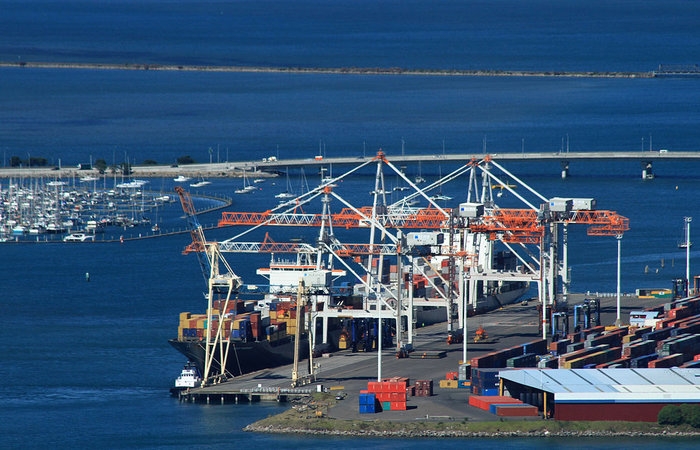
Content supplied by Statistics NZ
New Zealand’s top two export commodities, meat and dairy, both fell by value in 2016, Statistics New Zealand said today.
The total value of all export goods was $48.4 billion for the year ended December 2016, down $544 million from the previous year. This is the second annual fall in a row for exports. The latest annual total is $1.6 billion less than the high of the 2014 year.
The biggest fall by value was for meat and edible offal, our second largest export group, with sales down $909 million to $5.9 billion. The fall in meat was driven by beef (down $481 million) and lamb (down $415 million). The United States accounted for three-quarters of the fall in beef, while the European Union (EU) accounted for nearly half of the fall in lamb. The amount of meat fell 7.4 percent from 2015, with beef falling 14 percent and lamb falling 4.6 percent.
“The large fall in meat exports for 2016 reflects a decline from the record meat season in 2015 for both value and quantity,” international statistics senior manager Nicola Growden said. “The 2016 year’s meat exports have returned to levels similar to those seen in 2014.”
The quantity of milk powder, butter, and cheese exported rose to a new high of 3.0 million tonnes, despite a near 3 percent fall in the value of dairy exports to $11.2 billion.
The quantity of milk powder, butter, and cheese has been rising since 2013 and is now 14 percent higher than it was then. The quantity exported to China was 25 percent of the total in 2016, slightly up from 23 percent in 2015.
The value of imported goods was $51.6 billion in 2016, down $883 million (1.7 percent) from the high of the December 2015 year. The fall was led by cheaper oil and petrol, and partly offset by a rise in cars, trucks, and parts.
Oil and petrol fell $840 million in 2016, mainly due to crude oil (down $666 million). The value of crude oil has been falling for the past four years, and is now 55 percent lower than the 2012 value ($5.7 billion). The amount of crude oil imported rose 2.3 percent in 2016, and has been increasing for the past two years.
In 2016 there was an annual trade deficit of $3.2 billion (6.6 percent of exports). This is smaller than the deficit of $3.5 billion for the December 2015 year. The trade shortfall in 2015 was the largest December year deficit since 2008.
6 Comments
Farmers spray powdered milk on EU buildings in protest
http://www.upi.com/Top_News/World-News/2017/01/24/Farmers-spray-powdere…
Ted Ted
It's not so much the "minimum selling price" that determines the actual cost to the purchaser, rather it is the "landed price" and that is composed of such factors as "selling price" as well as "import duties", "tariffs", "countervailing duties" and many other factors designed to prevent the sale of a "subsidized" product (where "subsidized" can be defined to mean "able to be produced at a lower price due to the fact that labour costs are lower") into a market in such a way that it "adversely affects domestic producers".
For example, the price of powdered milk in New Zealand in "Contract 7" averaged US$3,325 a metric ton and having the EU "dump" powdered milk in New Zealand at US$2,300 would "work irreperable harm on the domestic New Zealand dairy industry". The fact that it would actually make powdered milk more affordable to the consumer (both individual and industrial) is totally irrelevant.
http://www.independent.ie/business/farming/dairy/hogan-cant-understand-…
Better to farm across the ditch?
http://www.sheepcentral.com/
Well this is a surprise, We have enlarged our population with high immigration numbers but our export income has gone down. We now have more people to share this income with so as a generalization NZ'ers are now poorer. Who saw that coming other than John Key who is getting out of Dodge.
New Zealand’s top two export commodities, meat and dairy, both fell by value in 2016, Statistics New Zealand said today.
Hmmmm...
In regards to a trade war between Beijing and Washington, the main risks may not only be economic. Economist Noah Smith writes that, without Trump’s protectionist policies, world trade, as a percentage of global GDP, peaked around 2004. Orthodox economic theory generally frowns upon protectionist policies for passing the costs onto consumers and thereby hurting trade. The equivocation, according to Smith, is that for the US and China large bilateral trade volumes are necessarily linked to mutual prosperity. Instead, lower trade does not reveal the full impact, Smith said. "It might be that large trade volumes make a country only a little better off in terms of real income, so that even a large reduction in trade flows hurts the economy only a little bit." Read more
AJ
That Aussie lamb price surely is liveweight??
We welcome your comments below. If you are not already registered, please register to comment.
Remember we welcome robust, respectful and insightful debate. We don't welcome abusive or defamatory comments and will de-register those repeatedly making such comments. Our current comment policy is here.